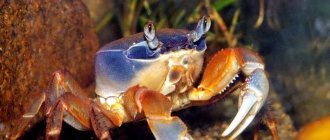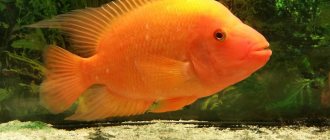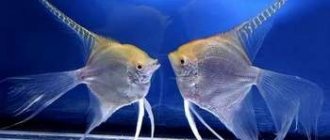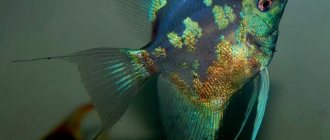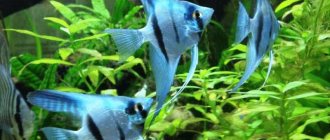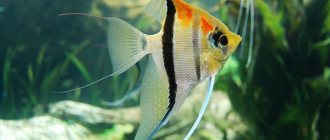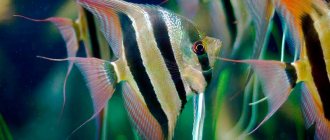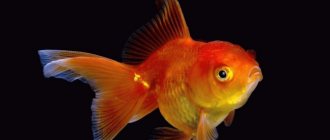General characteristics of angelfish
The fish have a small triangular body, laterally compressed. The long fins stretched upward give them true beauty. Under the abdomen they are transformed into long threads.
Due to the distribution of length (body - 15 cm, together with fins - 25-30 cm), angelfish look like a sail exposed to all the winds. The body is covered with small scales; in some species they create a delightful play of light.
The male differs from the female in having a convex forehead. In the aquarium, the fish behave calmly, imposingly swim throughout the pond, patiently waiting to be fed .
You can see angelfish active and aggressive only during the breeding season. The couple selflessly takes care of the caviar, does not allow anyone to get close to it, and attacks any intruder with a double blow.
Red devil angelfish compatibility
Angelfish red phantom
By nature, angelfish are peaceful schooling fish, however, during the breeding season they become very aggressive. It easily gets along with peace-loving fish species: small tetras (neons, amanda tetras, etc.), they look good with swordtails. They go well with corydoras and small loricariid catfish.
Angelfish are incompatible with: guppies, goldfish. Although discus fish are also “relatives,” in our opinion, they are not the best neighbors for angelfish. Discus love warm water 30+, they are capricious, and grow into large fish. In general, we are in favor of keeping discus fish separately - in a species aquarium.
Species diversity
The pure natural form of the fish can be found in the waters of the central Amazon.
sold in stores are obtained through selective breeding . Here are what they are, angelfish: types, photos with names.
Common angelfish
Aquarists have not been able to adapt wild representatives of Pterophyllum scalare, which are large in size, for home keeping.
Today, the common angelfish is a selective breed obtained by crossing the wild species and the Eimeki angelfish.
The fish has a silvery body, along which there are transverse black stripes. Body length is about 15 cm, height with fins is 20 cm.
Leopold
A rare species on sale with a brown body and barely visible stripes.
It got its name from King Leopold III, who reigned in Belgium. He was interested in zoology and sent an expedition to the Amazon, from where they brought such unusual fish.
Not the largest species with a body length of about 15 cm. It is distinguished by the neat shape of its fins, making up a proportional triangle pattern.
Diamond
A close relative of the golden angelfish, the diamond angelfish sparkles with magnificent scales. The silvery scales play in the light so much that they look like a scattering of diamonds.
This species is often used by breeders to develop new varieties of fish.
Bicolor
The decorative value of the species is in the distribution of dark and light colors on the body. The fish has half its body painted in a light tone, and closer to the tail in a dark tone.
If a bicolor angelfish acquires extra stripes, it loses its decorative effect and its value decreases.
Altum, or high fin
In the photo, this species looks very similar to a common angelfish, unless you notice that the stripes on the body have clearer lines.
The graceful shape of the fins adds a decorative touch to the look. Under natural conditions, the height of the altum reaches 45 cm. The fish loves spacious aquariums.
Platinum
Due to the light silvery shine of the scales that cover the entire body of the fish, it received the name “platinum”. She has no stripes on her body, and her fins are almost transparent.
Blue
The blue coloration of the angelfish is the result of a long and painstaking selection carried out by Filipino aquarist Ken Kennedy.
The successful fixation of the blue color led to the emergence of original varieties: blue zebra, platinum, diamond. The blue pinoy is always popular.
Interesting! Ken Kennedy gave impetus to the selection of Pinoys, thanks to which the Pinoy clown with a multifaceted color and the Smokey pinoy, or smoky angelfish, saw the light of day.
Blue Angel
The best representatives of the species are distinguished by a rich blue tint of their scales. Specimens without stripes and with translucent fins are expensive and are especially valued by angelfish lovers.
Experts reasonably believe that the blue angel is the primary form of all blue varieties.
Not inferior to her in beauty is the green angel, which for a long time was considered a rarity and almost never went on sale.
The fish is painted in golden-green tones. The stripes and spots on her body are not black, but olive green.
Blue pearl
The body of the fish is covered with small scales, which are colored in pearl shades, and in certain lighting they shine with a pearlescent sheen.
Golden
The intensity of the golden color of this angelfish is weak, not at all the same as that of a goldfish. However, for the pleasant yellowness of its scales with a silvery tint, it was called golden.
In color variations, the amount of yellow color changes: in one fish there is very little of it, in another it clearly prevails.
Leopard print
Along the silvery body of the leopard angelfish there are not stripes, but spots of different sizes.
The fish needs an aquarium with a sparsely populated water space: it does not like dense vegetation and multiple decorations.
Attention! This type of angelfish is not recommended to be kept in aquariums with a lot of greenery.
Koi angelfish
The color of this species is borrowed from the koi carp: a red-orange head, chaotic black strokes and a white base of the body.
Each fish has its own unique color pattern. Individuals that have little red on their heads are highly prized.
Red
The red variety is derived from the koi angelfish. Breeders selected individuals with a large amount of red pigment and brought the selection to obtain a monochromatic appearance.
In young fish, color appears gradually and reaches high saturation by the first year of life. To artificially maintain color, the fish are given Tetra Rubin.
Red Devil
The fish with the ominous name “red devil” is completely colored red, it has no inclusions or spots.
Peaceful in nature, she easily gets along with equally friendly neighbors.
Marble
The species is derived from the common angelfish, only it is smaller in size and has a pattern of black stripes, spots, and dots, similar to the colors of marble.
Body color is silver. The marble variety does not require a large aquarium.
Attention! Some individuals of the marbled variety have green and golden spots located on the forehead and back.
Zebra striped
The zebra fish is similar in appearance to its striped counterparts, however, the stripes on its body have well-defined boundaries, and they run more evenly along the body. The number of stripes is 4 or more, and the first of them passes through the eye of the fish.
Black
Breeders worked on this species for a long time. To ensure that the black coloration filled the entire body, they selected for crossing common angelfish with wide black stripes.
The resulting species has become very popular among aquarists, who are especially attracted by the black veil shape of the fish.
Interesting! Another spectacular variety is the black velvet, which has silver spots visible on its belly and fins.
Pink glowing
The species was bred by Glofish company specialists involved in genetic engineering. They got a fish with a delicate pink color and scales that glow in the dark.
The fish is expensive, so it is rarely found in home aquariums.
Dantum albino
The albino dantum is famous for its long fins, which stretch it to a height of 25–27 cm. The fish has poor eyesight and does not like bright light.
The aquarium for it should be equipped with reliable shelters and plants that create shaded areas. By nature it is unsociable, but gets along well with individuals of its species.
Veiled angelfish
The main advantage of the species is its beautifully curved long fins. However, such decoration forces owners to keep their pets separate from aggressive fish.
Veiled angelfish will only feel comfortable with fish that live in the bottom part of the tank.
Pearl
A recessive gene gave the pearl color to the fish. Mother-of-pearl tints are well expressed in individuals painted in light colors.
Paraiba phantom
This species has a double asexuality gene. Some aquarists classify it as a pearl variety with a blue color. Paraiba angelfish are said to be incapable of reproduction.
Manakapuru
An amazing looking angelfish, its silver body and black stripes complemented by a scarlet train along the back.
The species is named after the Brazilian region of Manakapur. The fish has a slightly elongated nose and striped fins.
Jacobin
An upturned nose, wide fins and beautiful stripes along the body and fins - this is what the original Jacobin looks like, which rarely appears on sale.
Rio nanay
The Peruvian altum with a body that is very elongated in height belongs to the high-finned varieties. If fins are added to the body, its height will be 40 cm.
The fish is also called Rio Nanai. The body of the angelfish is decorated with two black stripes, the back one smoothly blends into the lower edge of the fins.
Birch
The fish got its name for its peculiar pattern of black stripes, which is very similar to the coloring of birch bark. The main body tone is silver.
Dwarf
Dwarf, or mini angelfish, are not a separate species, but a defect in the development of the fish that arose due to poor feeding or non-compliance with maintenance standards.
Breeding and reproduction of red phantom angelfish
Angelfish red phantom
Males court females during mating season. Both the male and the female guard the eggs, which are attached to the surface of aquatic vegetation in the area of the nest.
Sexual differences between male and female angelfish are weakly expressed. They can only be noticed when the fish reach sexual maturity at 9-12 months of age. Until this moment, when purchasing young specimens at a pet store, no one will tell you which one you are getting.
From fish breeding expert Vitaly Chernyavsky :
“1) Behavior is not a criterion. Quite often, 2 females without a male completely even (and in turns) imitate the sexual behavior of the male. Only, if you look closely, you can see that the “male” and the female will then switch places - and eggs (naturally unfertilized) will be laid by BOTH fish.
2) There are males without a forehead and females with a forehead.
3) The only clear criterion for sexual differences in adult fish is the line of the back and abdomen. In the male: the back line and dorsal fin form an ANGLE, and the abdomen and anal fin form an almost STRAIGHT line. But in the female it’s the other way around: the back line and dorsal fin are almost a STRAIGHT line, and the abdomen and anal fin are almost a right ANGLE.”
Taking into account the expert's opinion, we also add this drawing, which will help determine the sex of the Kalaria based on the angle of its fins.
!!!PLEASE ATTENTION!!!
The fact is that this drawing of an angelfish is distributed everywhere on the Internet with false information - the male and female are confused. This drawing is taken from Ilyin’s book “Aquarium Fish Farming”. So, there the fish were CONFUSED by the artist.
Well, on the Internet, those who make this drawing on their websites... do not themselves decide where the female is and where the male is, thereby misleading everyone. Everything is correct in this drawing!
With good and comfortable maintenance of the angelfish, spawning occurs directly in the general aquarium. The stimulus for spawning is replacing the aquarium water with fresh water and increasing the temperature by 2-4 degrees. The masonry substrate plays a very important role in this process. Angelfish often prefer to lay their eggs on a broad-leaved plant, but they may also like other places: a filter tube, glass, the wall of a grotto, etc.
The place chosen by the parents is carefully cleaned of all dirt, and then the spawning itself follows. At a time, a female can lay about 500 eggs, a large one and even more up to 1000.
The incubation period of the eggs is two days, during this period the parents vigorously fan the eggs with their fins and clean them of specks, and remove the whitened - dead eggs. After the larvae hatch from the eggs, the parents transfer them in their mouths to another leaf. This is done for greater cleanliness and to eliminate the possibility of catching an infection from the rotting shell of the caviar.
Over the next 7 days, the larvae, under the watchful supervision of their parents, hang on the leaf. When the larvae run out of nutrients from the yolk sac, they turn into fry. From this time they should start feeding.
Starter food for juvenile angelfish should be of high quality, live and well washed. I can recommend nauplii, nematodes. It is not advisable, but you can feed the fry with any ground dry food (this feeding will increase the number of dead fry). It is also recommended to clean the spawning aquarium from food debris and other dirt twice a day.
The above process is a reference example of angelfish reproduction.
Often, due to the proximity to other fish in a common aquarium, the parents experience a lot of stress, and the juveniles too. This, of course, does not lead to anything good. There have even been cases where parents, stressed by their neighbors, ate their offspring. In addition, due to the fact that in industrial breeding of angelfish, the method of spawning is used, it is now difficult to find a conscientious pair of parents who would be able to produce offspring on their own. This is considered a miracle.
With this in mind, usually immediately after spawning, the eggs with the leaf on which they are located are transplanted into another aquarium with a volume of 10-20 liters. In this case, all parental functions are transferred to your shoulders. To protect eggs from fungal diseases, methylene blue is added to the water, whitish dead eggs are regularly removed with a pipette, and a spray bottle with a very weak aerated flow of water is placed under the leaf.
Diseases of angelfish
Below are the most common symptoms of common angelfish diseases:
- rubs against various objects - invasion (fish semolina, oodium, etc.). It is treated with all drugs containing malachite green and formaldehyde: Tetra Contralk, Sera Kostapur, Antipar.
- produces rocking movements throughout the body, bloating, ruffling - inflammation of the gastrointestinal tract. If the stage is non-terminal, it is treated with metronidazole.
— The angelfish has a cloudy eye. As a rule, it occurs due to clashes. For mild injuries - iodinol. Moderate severity - Metrogyl is dripped directly onto the eye. Severe - serious septic tanks. In general, it goes away on its own within a couple of weeks (provided there are no further fights or stress).
- Moss, cotton wool fluff on the body - mushrooms. Any fungicidal agent. Regular methylene blue will help.
Compatibility of angelfish of different subspecies
All scalars are peaceful and conflict-free . The aristocratic nature is incompatible with squabbles and scandals, however, during the spawning period, the aggressive nature of cichlids breaks out in them, and they mercilessly attack everyone who swims near them.
You can take them as neighbors:
- swordtails;
- mollies;
- gourami;
- Laliusov.
Fish that lead a bottom-dwelling lifestyle, such as catfish, do not interfere with them either.
Angelfish are not kept with goldfish and discus fish due to different water temperature requirements.
Small species should be introduced into the aquarium with caution. Some of them can be used as food for noble cichlids. Large predators are also undesirable: they often tear off the fins of angelfish.
